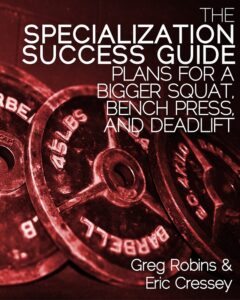
Strength Strategies – Installment 3
I figured it’d be a good time to add another installment to this series, as today is the last day of the sale on The Specialization Success Guide. Through midnight tonight (Sunday), you can save 40% by entering the coupon code ROBINS at checkout HERE.
Here are six strategies to help you in your strength pursuits:
1. Be a beltless badass.
My wife has a very good deadlift for someone who’s never competed in powerlifting; she’s pulled close to 300 pounds, which is about 2.5 times her body weight. What’s most impressive to me, though, is that even when she gets up to 95-100% of her best deadlift, her form never breaks down. This has a lot to do with consistent coaching early on, and the right pace to progressions over the ten years I’ve known her.
That said, I also think that it has a ton to do with never wearing a lifting belt. Seriously, she has never put on one. Likewise, I have athletes who have been with us for close to a decade who have never worn one, either. I’m a big believer:
[bctt tweet=”Optimal long-term technique and strength success is built on a beltless foundation.”]
Interesting, on this point, I reached out to Tony Bonvechio, and he said that most of his novice lifters will gain about 20% on their squat and deadlifts by wearing a belt.
Conversely, Tony himself gets about 9%, and I’m slightly less than that (6-7%). I reached out to some very accomplished lifters, and after crunching the numbers between raw and belted PRs, none of them were over 10% difference.
To this end, I think a big training goal should be to reduce the “Belt Deficit.” Training beltless is a great way to make sure that “ugly strength” doesn’t outpace technique in beginning lifters, and it can also be a hugely helpful training initiative for more advanced lifters who may have become too reliant on this implement.
2. Don’t be afraid to gain some weight.
Make no mistake about it; you can improve strength without gaining weight. It can, however, be like trying to demolish a 30-story building with an ice pick instead of dynamite.
I’ve had some success as lightweight (165-181-pound class) lifter, but this can be misleading because there have been multiple times in my lifting career when I’ve pushed calories to make strength gains come faster. In the fall of 2003, for instance, I went from 158 up to 191, and then cut back to a leaner 165. In the summer of 2006, I got up to 202, then back down to the mid 180s. These weight jumps made me much more comfortable supporting heavy weights in the squat and bench press, as a little body weight goes a long way on these lifts.

3. Learn to evaluate progress in different ways.
Traditionally, powerlifters have only cared about evaluating progress with the “Big 3” lifts. Unfortunately, those aren’t going to improve in every single training session. To some degree, the Westside system of powerlifting works around this by rotating “Max Effort” exercises – but even with rotating exercises, it’s still an approach that relies on testing maximal strength on a very regular basis. Occasionally, it’ll lead to disappointments even over the course of very successful training cycles.
For this reason, we always encourage individuals to find different ways to monitor progress. Tracking bar speed can be great, whether you have technology to actually do it, or you’re just subjectively rating how fast you’re lifting. A lower rating of perceived exertion (RPE) at a given weight would also indicate progress.
Volume based measures are also useful. Hitting a few more reps with the same weight during your assistance work is invaluable; those reps add up over the course of a longer training cycle. Also, making a training session more dense (more work in the same or less amount of time) can yield great outcomes.
Looking for more strength strategies or – better yet – programs to take the guesswork out of things for you? Check out The Specialization Success Guide, a resource for those specifically focused on improving the squat, bench press, and deadlift.



